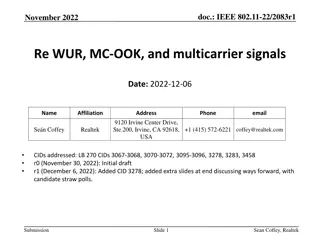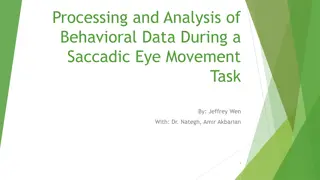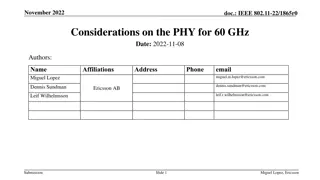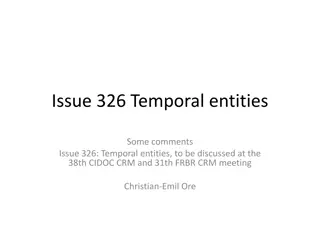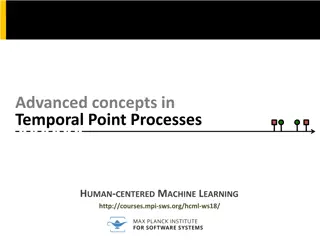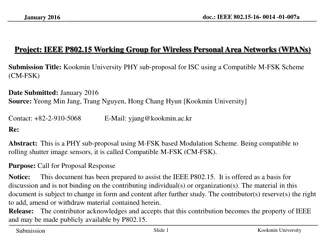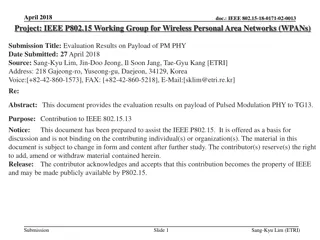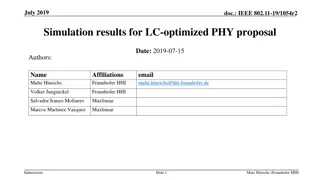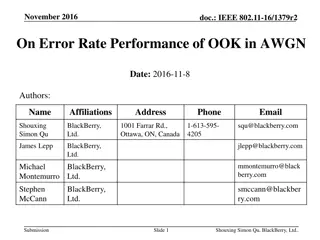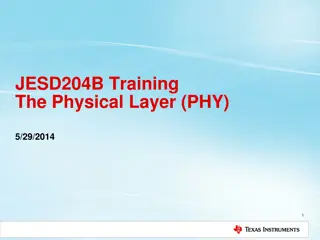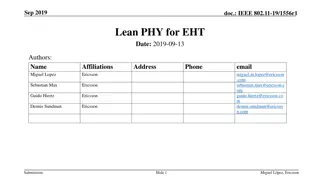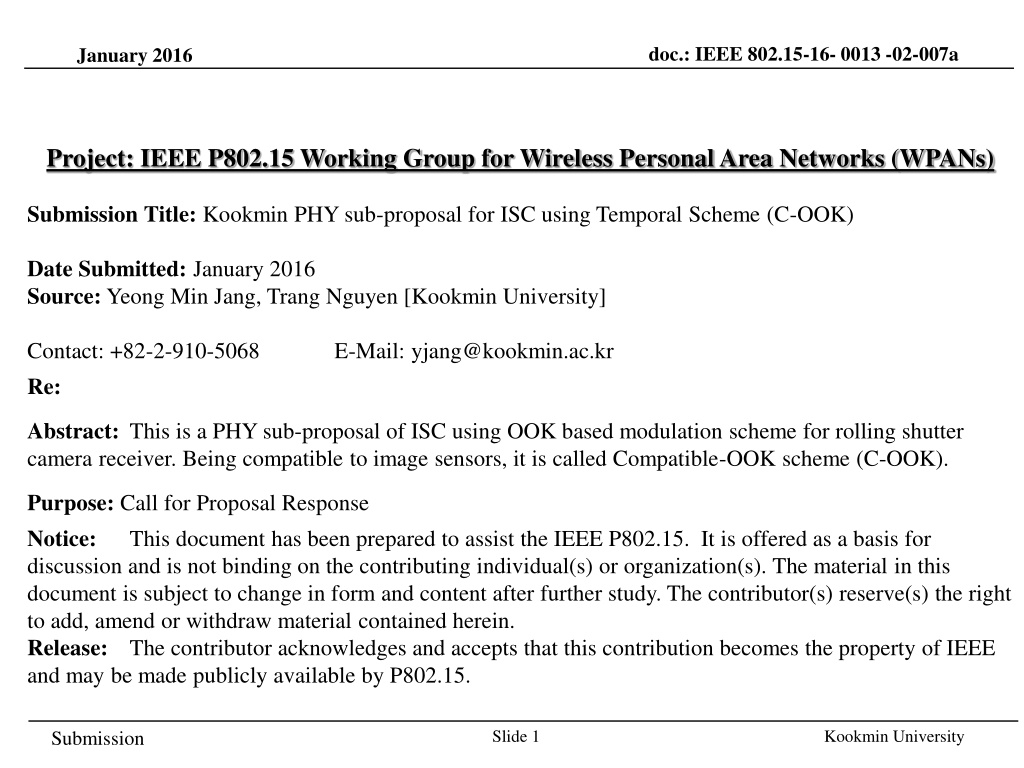
Kookmin PHY Sub-Proposal for ISC Using Temporal Scheme
Explore Kookmin University's PHY sub-proposal for ISC with a focus on temporal scheme (C-OOK) modulation for rolling shutter camera receivers. The proposal discusses design considerations, system architecture, data packet structures, asynchronous decoding, and packet recovery methods. Learn about varying frame rates, rolling exposure times, clock rates, and more in this innovative submission.
Download Presentation

Please find below an Image/Link to download the presentation.
The content on the website is provided AS IS for your information and personal use only. It may not be sold, licensed, or shared on other websites without obtaining consent from the author. If you encounter any issues during the download, it is possible that the publisher has removed the file from their server.
You are allowed to download the files provided on this website for personal or commercial use, subject to the condition that they are used lawfully. All files are the property of their respective owners.
The content on the website is provided AS IS for your information and personal use only. It may not be sold, licensed, or shared on other websites without obtaining consent from the author.
E N D
Presentation Transcript
doc.: IEEE 802.15-16- 0013 -02-007a January 2016 Project: IEEE P802.15 Working Group for Wireless Personal Area Networks (WPANs) Submission Title: Kookmin PHY sub-proposal for ISC using Temporal Scheme (C-OOK) Date Submitted: January 2016 Source: Yeong Min Jang, Trang Nguyen [Kookmin University] Contact: +82-2-910-5068 Re: E-Mail: yjang@kookmin.ac.kr Abstract: This is a PHY sub-proposal of ISC using OOK based modulation scheme for rolling shutter camera receiver. Being compatible to image sensors, it is called Compatible-OOK scheme (C-OOK). Purpose: Call for Proposal Response Notice: This document has been prepared to assist the IEEE P802.15. It is offered as a basis for discussion and is not binding on the contributing individual(s) or organization(s). The material in this document is subject to change in form and content after further study. The contributor(s) reserve(s) the right to add, amend or withdraw material contained herein. Release: The contributor acknowledges and accepts that this contribution becomes the property of IEEE and may be made publicly available by P802.15. Slide 1 Kookmin University Submission
doc.: IEEE 802.15-16- 0013 -02-007a January 2016 Content PHY design considerations Frame rate variation Different sampling rates Different rolling exposure time System designs System architecture Frequency band in use Data packet structure Asynchronous Decoding Packet recovery PHY format and PHY modes Slide 2 Kookmin University Submission
doc.: IEEE 802.15-16- 0013 -02-007a January 2016 Definitions varying frame rate ISC mode: an ISC mode that supports a varying frame-rate receiver. asynchronous decoding: a decoding procedure under presence of frame rate variation. optical clock rate (modulation rate): The frequency at which the data is clocked out to the optical source. In flicker-free mode, let assume the frequency no less than 200Hz to be invisible to human eyes. asynchronous bit: a form of clock information in the temporal scheme helping a varying frame rate receiver in asynchronous-decoding. Note that this is not only necessarily one single bit (bit 1 or bit 0), but also can be a symbol (a set of bits in which symbol 1 and symbol 0 are orthogonal some how) to operate at high noise affected. clock information (of a data packet/symbol): The information represents the state of a symbol clocked out. The clock information is transmitted along with a symbol to help a receiver identifying an arrival state of new symbol under presence of frame rate variation. rolling exposure time: the time from the first line to the last line exposes to light in a rolling shutter image sensor. rolling sampling rate: // forward decoding: a decoding process in asynchronous decoding that taken from the position of the SF backward on a rolling image. backward decoding: a decoding process in asynchronous decoding that taken from the position of the SF forward on a rolling image. packet recovery: a process in asynchronous decoding that recovers a complete data packet from the incomplete data parts decoded, forward and backward part of one (two) data packet(s). data fusion: a process in asynchronous decoding to group data parts (forward and backward parts) those belong to one packet. There are two types of data fusion that happens according to the value of asynchronous bits: inter-frame fusion: to group data parts from different images intra-frame fusion: to group data parts from an image. Slide 3 Kookmin University Submission
doc.: IEEE 802.15-16- 0013 -02-007a January 2016 PHY design considerations Slide 4 Kookmin University Submission
doc.: IEEE 802.15-16- 0013 -02-007a January 2016 Frame rate variation Symbol clock out symbol i symbol (i+1) Rolling camera sampling (at high frame rate) Rolling camera sampling (at low frame rate) Packet Fusion (Recovery) symbol i voting symbol (i+1) voting Clock interval Max{sampling interval} Slide 5 Kookmin University Submission
doc.: IEEE 802.15-16- 0013 -02-007a January 2016 Different sampling rates Sampling interval rolling exposure Source: http://www.onsemi.com/pub_link/Collateral/NOIV1SN1300AD.PDF Rolling shutter Operation The sampling rate of a Smartphone rolling image sensor is different from the other s, and typically larger than 15 kHz. The light modulation and demodulation of a frequency will need to be compatible to different cameras those have different sampling rates. Slide 6 Kookmin University Submission
doc.: IEEE 802.15-16- 0013 -02-007a January 2016 Different rolling exposures Symbol clock out symbol i symbol (i+1) rolling exposure time rolling exposure time rolling exposure time Rolling camera sampling (at low frame rate) losing information losing information Data Fusion symbol (i+1) Packet Recovery symbol i The rolling exposure time decides how much the amount of data is recorded per a rolling image. Under presence of frame rate variation, different rolling exposure time is challenging. Slide 7 Kookmin University Submission
doc.: IEEE 802.15-16- 0013 -02-007a January 2016 System Design Slide 8 Kookmin University Submission
doc.: IEEE 802.15-16- 0013 -02-007a January 2016 System Architecture Transmitter side Receiver side clock information (of a data packet): In this scheme, asynchronous bits (Ab) are in form of clock information. Clock information Ab = 1 Symbol clock out Clock information Ab= 0 Merger data packet i Ab=1 Ab=1 data packet i Slide 9 Kookmin University Submission
doc.: IEEE 802.15-16- 0013 -02-007a January 2016 Modulation frequency Camera cut-off In-band Eye cut-off Camera shutter speed ~8 kHz ~200 Hz The modulation frequency is constant on a frame. The upper threshold of frequency band in use is less than the shutter speed of camera (Currently, Smartphone has a shutter speed of 8kHz). Frequency Compatibility 2 kHz Webcams, Smartphone cameras (Auto-exposure is OFF) 4 kHz Smartphone cameras (Auto-exposure is OFF) The practical response of a long-exposure-camera (A webcam) Slide 10 Kookmin University Submission
doc.: IEEE 802.15-16- 0013 -02-007a January 2016 Data packet Structure Slide 11 Kookmin University Submission
doc.: IEEE 802.15-16- 0013 -02-007a January 2016 Data packet structure packet (i-1) packet (i+1) packet i DS i (1) DS i (2) DS i (N) Data packet i SF Ab Ab DS: Data Sub-Packet; SF: Start Packet-Frame Symbol; Ab: Asynchronous bit(s) A packet is multiple times repeat of one data symbol. A complete DS has a very-low-header symbol (SF), two similar asynchronous bits (which is a form of the clock information) Slide 12 Kookmin University Submission
doc.: IEEE 802.15-16- 0013 -02-007a January 2016 Data packet structure: The purpose of repetition packet (i-1) packet (i+1) packet i DS i (1) DS i (2) DS i (N) Problem of losing repeated ones (is mitigated by using our frame structure) recorded a complete DS Repetition is to avoid losing any data when camera makes sampling discretely. Slide 13 Kookmin University Submission
doc.: IEEE 802.15-16- 0013 -02-007a January 2016 Data packet structure: The purpose of Asynchronous bits DS i (N-1) DS i (N) DS i+1 (1) DS i+1 (2) data packet i data packet (i+1) Ab=1 Ab=1 Ab=0 Ab=0 Ab=0 Ab=1 Rolling exposure time Apart of packet (i+1) Apart of data packet i Ab=1 Ab=0 Ab=1 Ab=0 Ab=1 Ab=0 data packet i Apart of packet (i+1) data packet i Apart of data packet i . . . . . . A group of (packet i+1) for voting A group of (packet i) for voting Asynchronous bits decide how to group adjacent decoded data packets (complete or apart) into a voting Slide 14 Kookmin University Submission
doc.: IEEE 802.15-16- 0013 -02-007a January 2016 Data packet structure: The SF symbol Ab SF symbol Ab Data 011100 Manchester coding 0011111000 4B6B coding bit 1/0 bit 1/0 000011111111100000 8B10B coding Backward decoding SF #n Forward decoding A SF symbol is detectable. When the frame rate is varying irregularly, the position of the SF symbol on the rolling image is also varying. The detection of SF becomes indispensable for the decoding (forward and backward parts) and recovering data. The length of SF is different for each RLL code (in order to be low-overhead and detectable). Slide 15 Kookmin University Submission
doc.: IEEE 802.15-16- 0013 -02-007a January 2016 Asynchronous Decoding Slide 16 Kookmin University Submission
doc.: IEEE 802.15-16- 0013 -02-007a January 2016 Decoding Procedure SF detection: to detect the position of SF on a rolling image. Asynchronous decoding: From the position of SF, two tasks are performed Forward decoding: Decode the forward part of the image Backward decoding: Decode the backward part of the image Packet recovery: To recover a complete data packet from the incomplete parts decoded, forward and backward part of one (two) data packet(s): Data fusion: to group parts (forward and backward parts) those belong to one packet. This is indispensable because a camera has a rolling exposure time different from the other camera s and not equal to DS interval. Majority voting: to get a complete packet from several discrete-parts of the packet. Slide 17 Kookmin University Submission
doc.: IEEE 802.15-16- 0013 -02-007a January 2016 Asynchronous Decoding: Rolling exposure time >> (DS interval) SF SF SF Oversampled Asynchronous decoding This happens when the DS interval is short to be compatible to different rolling exposure times The majority voting is applied between several images or within an image (using asynchronous bits) to enhance BER. Slide 18 Kookmin University Submission
doc.: IEEE 802.15-16- 0013 -02-007a January 2016 Asynchronous Decoding: Rolling exposure time ~ (DS interval) SF 1 4B6B-Data (Backward) 1 4B6B-Data (Forward) Data Fusion Packet recovery Data (Forward) Data (Backward) Forward decoding and Backward decoding When the rolling exposure time is almost equal to DS interval, forward and backward are both used to get 100% information of an image. The fusion of forward part and backward part (of a data packet) is performed to output a complete data packet. Slide 19 Kookmin University Submission
doc.: IEEE 802.15-16- 0013 -02-007a January 2016 Packet Recovery Packet 1: Ab(s)=1 Packet 3: Ab(s)=1 Packet 2: Ab(s)=0 SF Ab=1 Ab=0 Ab=0 Ab=1 Inter-frame fusion Packet #2 Packet #1 intra-frame fusion Ab=1 Packet #1 Ab=0 Packet #2 Two cases may happen at different sampling time: Case 1- Inter-frame data fusion: Fusing two sub-parts of a packet at two different images into a complete packet. Case 2- Intra-frame data fusion: Recovering a complete packet from an image. Slide 20 Kookmin University Submission
doc.: IEEE 802.15-16- 0013 -02-007a January 2016 PHY frame format Slide 21 Kookmin University Submission
doc.: IEEE 802.15-16- 0013 -02-007a January 2016 PHY Frame Format Preamble and training PHY header HCS PSDU SHR PHR PHY payload CM-FSK packet (i-1) packet (i+1) packet i DS i (1) DS i (2) DS i (N) Data packet i SF Ab(1) Ab(2) Data rate related (TBD) Packet rate DS rate : 5/10/15 (packet/sec) : 60/120 (DS/sec) Slide 22 Kookmin University Submission
doc.: IEEE 802.15-16- 0013 -02-007a January 2016 Medium-rate PHY I modes MCS indication PHY modes Data rate Unit 7 0000 0110 I.7 0.084 8 0000 0111 I.8 0.17 9 0000 1000 I.9 kbps 0.22 10 0000 1001 I.10 0.44 11 0000 1010 I.11 0.53 Detail parameters in medium-rate PHY I modes (using C-OOK) Data rate (e.g. 10 sym/s) 84 bps 0.17 kbps 0.22 kbps 0.44 kbps 0.53 kbps Compatibility Support Varying frame rates Y Y Y Y Y Optical Clock rate Symbol rate DS rate 2 kHz 5/ 10/ 15 2 kHz 5/ 10/ 15 2 kHz 5/ 10/ 15 4 kHz 5/ 10/ 15 4 kHz 5/ 10/ 15 Shutter speeds/ Sampling rates Y Y Y Y Y Modulation OOK based OOK based OOK based OOK based OOK based Coding Manchester Manchester 4B6B 4B6B 8B10B 7 8 9 120 60 60 60 60 Medium PHY I (kbps) 10 11 Slide 23 Kookmin University Submission
doc.: IEEE 802.15-16- 0013 -02-007a January 2016 Appendix 1: Image processing technique Slide 24 Kookmin University Submission
doc.: IEEE 802.15-16- 0013 -02-007a January 2016 1D Waveform De-trending - A waveform is extracted from image needs to be de-trended. In order to detrend signal, the baseline of signal is estimated. 3rd order-polynomial line or B-spline line, or Wavelet-line can be applied to estimate baseline of signal. - De-trend signal for SF detection using 3rd order polynomial fitting and Wavelet baseline Slide 25 Kookmin University Submission
doc.: IEEE 802.15-16- 0013 -02-007a January 2016 1D Signal processing and SF Detection In asynchronous decoding, the position of SF symbol is critical to forward decoding and backward decoding Result of Zero-crossing detection in an sample of a rolling image Zero-crossing detection method: Advantage: High accurate SF detection even though the signal strength is low Consideration: In case of dimming (AB% 50%) the baseline (offset line) of signal should be estimated carefully for zeros detection. Slide 26 Kookmin University Submission
doc.: IEEE 802.15-16- 0013 -02-007a January 2016 1D Signal processing and Decoding 2- By using asynchronous bits, the variation in camera frame rate is mitigated. 1-This part detects SF and necessary information for decoding Flow chart of asynchronous decoding using Zero-crossing detection algorithm Slide 27 Kookmin University Submission
doc.: IEEE 802.15-16- 0013 -02-007a January 2016 Link rate Estimation 8000 Manchester 4B6B 6000 8B10B Data rate [bps] 4000 2000 0 0 2000 4000 6000 8000 Modulation frequency used (Hz) Slide 28 Kookmin University Submission
doc.: IEEE 802.15-16- 0013 -02-007a January 2016 Appendix 2: Solution for frame rate drop to less than symbol rate <Question from Intel> At first, Kookmin always assume that there is no missing symbol. If frame rate drops too low, the error happens due to missing symbol and will be corrected by using line coding. This solution related to FCS (outer correction coding) and shows how we detect the missed symbol for better error correction. Kookmin has no interest and contribution about FCS until now.; and we are willing to collaborate and merge proposals for this idea. Slide 29 Kookmin University Submission
doc.: IEEE 802.15-16- 0013 -02-007a January 2016 Problem: Frame rate drop to symbol rate Ab=1 Ab=1 Symbol clock out Ab=0 symbol i symbol (i+1) symbol (i+2) Rolling camera sampling (at high frame rate) is no matter Miss a symbol Problem (at too low frame rate) Packet Fusion (Recovery) Ab= 1: (error in grouping images) Slide 30 Kookmin University Submission
doc.: IEEE 802.15-16- 0013 -02-007a January 2016 Solution: More asynchronous bit to detect missing frame Ab1=1 Ab1=0 Asynchronous bit 1 Ab2=1 Ab2=1 Asynchronous bit 2 Ab2=0 symbol i symbol (i+1) symbol (i+2) (at too low frame rate) Grouping image samples Asyn bits =10 Missed a symbol Asynchronous bits=11 Slide 31 Kookmin University Submission
doc.: IEEE 802.15-16- 0013 -02-007a January 2016 PHY Frame Format: 2 asynchronous bits to detect 1 symbol missing packet (i-1) packet (i+1) packet i DS i (1) DS i (2) DS i (N) Ab(2) Data packet i Ab(1) Ab(2) Ab(1) SF How many missing symbols can be detected? 1 Asynchronous bit 2 Asynchronous bits 3 Asynchronous bits : None : 3 continuous missed symbols can be detected : 23 -1= 7 continuous missed symbols can be detected Slide 32 Kookmin University Submission
doc.: IEEE 802.15-16- 0013 -02-007a January 2016 PHY Frame Format: Need FCS to recover the missed symbol/packet packet (0) packet 1 packet (N) FCS Need FCS to recover the missed symbol FCS length is proportional to (the number of missed symbols)/ (total symbols) Slide 33 Kookmin University Submission



